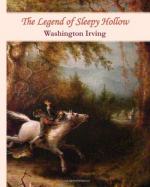|
This section contains 4,157 words (approx. 14 pages at 300 words per page) |

|
SOURCE: ‘Girls can take care of themselves’: Gender and Storytelling in Washington Irving's ‘The Legend of Sleepy Hollow,’” Studies in Short Fiction, Vol. 30, No. 2, Spring, 1993, pp. 175-84.
In the following essay, Plummer and Nelson explore gender ideology in “The Legend of Sleepy Hollow,” arguing that the story reflects Irving's misogynist beliefs.
Discussions of Washington Irving often concern gender and the artistic imagination, but these topics are usually mutually exclusive when associated with the two most enduring stories from the Sketch Book of Geoffrey Crayon, Gent. (1819-20): “Rip Van Winkle” and “The Legend of Sleepy Hollow.” Many readings of the former focus on gender, while discussions of the latter most often explore its conception of the artist's role in American society.1 “The Legend of Sleepy Hollow” does indeed address this second theme, but also complicates it by making art an issue of gender. Ichabod Crane is not only a...
|
This section contains 4,157 words (approx. 14 pages at 300 words per page) |

|


